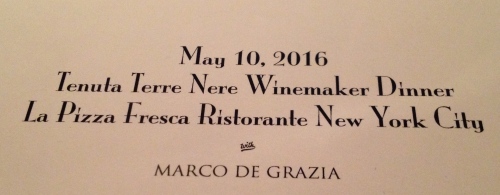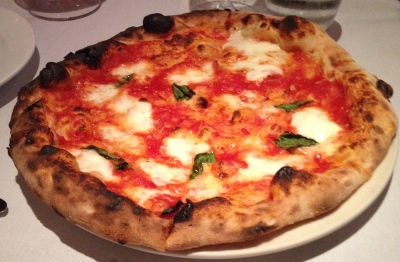I have a long history with the wines of Firriato from Sicily. When I was the wine director for I Trulli restaurant in NYC, I was introduced to them by one of the wine salespeople. Knowing my taste, he believed that I would like the wines and he was right.
Next, Michele and I went to Sicily where we visited the Firriato estate near Trapani. We were treated to a typical Sicilian lunch paired with their wines and learned to appreciate them even more. Then, a few years ago I attended a lunch at Il Gattopardo Restaurant in NYC where I enjoyed the more current vintages.
Recently, I was asked if I wanted to taste a number of samples from the winery and I accepted gladly.
The winery
Firriato is a family run business; the president is Salvatore Di Gaetano, the CEO is Vinzia Novara Di Gaetano, the COO Is Federico Lombardo di Monte Iato, and the Chairman is Irene Di Gaetano Lombardo di Monte Iato.
Firriato is comprised of 6 estates, four of which are near Trapani: Baglio Soria, Borgo Guanini — the largest with over 140 hectares of vineyards, Pianoro Cuddia and the Dagala Borromeo. On the east coast near Mount Etna is the Cavanera estate that has 11 hectares of vines. Off the coast of Trapani are the Egadi Islands. The Calamoni estate is on the island of Favignana.
Le Sabbie Dell’Etna Etna Bianco DOC 2016 made from Carricante and Catarrato from the territory of Castiglione di Sicily (Catania) at the Cavanera Estate. The soil is loamy-sandy of volcanic origin with good drainage. The vineyards are on the northeastern side of the volcano at 720 meters. The soil is loamy-sandy of volcanic origin with good drainage and there are 4,000 to 4,500 vines per hectare and the vines are cordon royat trained(trellises). Harvest is the second week of October. Fermentation lasts for 15 days. Vinification: soft pressing and fermentation at a controlled temperature. The wine remains for 3 months on the lees in steel tanks with daily shaking and remains in bottle for two months before release. This is a fruity wine with hints of white peaches and pears.
Favinia “La Muciara” Bianco 2014 IGT Sicily. Made from Grillo, Catarratto and Zibibbo. The grapes were grown on the Island of Favignana off the west coast of Sicily. They are grown at the Tenuta Calamoni estate, which is two meters from the sea. The training system for the vines is alberello and there are 5,000 vines per hectare. Harvest is by hand during the first week in September and the grapes are placed in small baskets. In the winery soft pressing is followed by fermentation for 20 days in temperature-controlled stainless steel tanks. The wine is aged for 6 months in stainless steel and for 2 more months in bottle before release. The heat during the day and the ocean breeze make for a wine with a mineral character and good acidity. The vineyards are 10 years old.
Ribeca DOC Sicily 2013 made from 100% Perricone from the Pianoro Cuddia Estate in the Trapani countryside. The soil is clayey and the vineyards have a south/southwest exposure and are at 200 meters. The training system is guyot and there are 5,000/6,000 vines per hectare. Grapes are hand picked the third week of September and the first week of October. Fermentation is for 14 days at 26/28 degrees C. in temperature controlled steel tanks in to red wine tradition. The wine is aged for 10/12 months in French durmast barrique. The wine has hints of cherries and blueberries with a touch of prune and juniper.
Le Sabbie Dell’Etna Etna Rosso DOC 2015 made from Nerello Mascalese and Nerello Cappuccio from the Cavanera Etna Estate at the Northern side of the Volcano at 700 meters. The soil is loamy-sandy of volcanic origin with good drainage and the vines are cordon royat trained and there are 4,000 to 4,500 plants per hectare. Gapes are hand picked the 2nd and 3rd weeks in October. Fermentation lasts for 14 days. Vinification is carried out according to tradition. The wine is aged in durmast barriques for 6 months and in bottle for 2 months before release. The wine has hints of black cherry, prune with a touch of licorice.
Cavanera “Rovo delle Coturnie” Etna Rosso DOC 2013 made from Nerello Mascalese and Nerello Cappuccio from the Cavanera Etna Estate. The soil composition is loamy-sandy of volcanic origin with good drainage. The vineyards are on the northeastern side of the volcano at 750 meters and there are 3,000 to 4,000 vines per hectare. Harvest is by hand the 2nd and 3rd weeks of October. Fermentation is for 18 days. Vinification in frustum of cone shaped wooden, according to tradition. The wine is aged for 9 months in French barriques and for 6 months in Slovenian durmast. The wine has hints of red fruit, peach a hint of black pepper and good minerality.
Santgostino “Bagio Soria” Terre Siciliane IGT 2012 made from Nero d’Avola and Syrah. The vineyards have a south/south westerly exposure and are at 200 meters. The soil is calcareous-clay and the vines are cordon trained, spur pruned/guyot and there are 5,000/6,000 vines per hectare. Hand harvest the first week of September for the Syrah and the second week of September for the Nero’d Avola.
Traditional vinification in temperature controlled steel tanks.
The wine is aged for 8 months in American Durmast barriques and 6 months in bottle before release. The wine has hints of wild berries, cherries and a touch of prune, clove and licorice.
Chiaramonte Terre Siciliane 2015 IGT 100% Nero d’Avola from Tenuta Dagala Borromeo in the Trapani countryside. The vineyards have a south/south-westerly exposure and are at 230 meters. The soil is mid-mixture, mostly clay, vines are cordon trained, spur pruned/guyot and there are 5,000 to 5,500 vines per hectare. Harvest takes place the third week of September. Fermentation lasts for 10 days. Vinification in temperature controlled stainless steel tank according to tradition. The wine is aged for 6 months in American durmast barrriques and in bottle for 3 months before release. The wine has hints of black cherries and blueberries with a touch of black pepper and cloves.
Harmonium Sicily DOC Sicily 2013 100% Nero d’Avola from the Borgo Guarini Estate. This is a “cru” from 3 vineyards: Ferla cru with a north-east exposure, Beccaccia cru with a south exposure and the Lepre cru with a south-east exposure. They are at 300 meters. The soil is calcareous-slime, there are 5,000/5,500 vines per hectare and the vines are cordon trained and spur pruned. Grapes are hand-picked the third week of September. Vinification in temperature controlled steel tanks according to tradition. The wine is aged for 12 months in French and American durmast barriques. This is a well-structured wine with hints of cherry, blueberries, prunes and a hint of pepper and nutmeg.
Passito IGT Sicily “L’ECRÙ” 2008 made from Moscato and a small amount of Malmsey from the Tenuta Borgo estate in the Trapani countryside. The soil here is of medium texture; mostly clay and the vineyards have a north-south exposure at 250/400 meters. There are 5,500 vines per hectare and the training is cordon spur pruned/guyot.
The harvest takes place the first week of September and the most mature grapes are hand harvested. The rest remain on the vines until they reach full maturity. Soft pressing of the grapes and the fermentation at controlled temperature lasts for 4 weeks. The wine is aged in bottle for 4 months before release. This is a very elegant dessert wine with aromas of candied orange peels, dried figs and dates. It has a clean but long finish and wonderful aftertaste.










